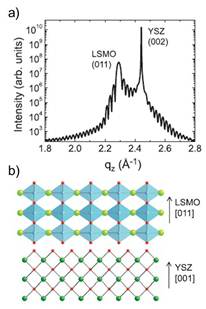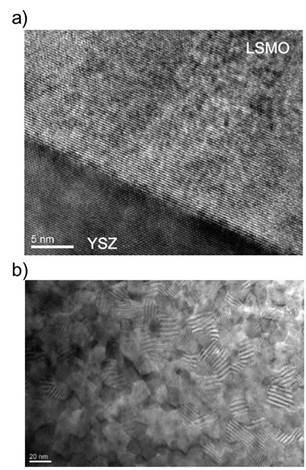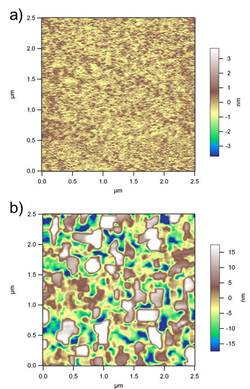57th Annual Report on Research 2012 Under Sponsorship of the ACS Petroleum Research Fund
Reports: DNI1051436-DNI10: Synthesis and Structure of Layered Perovskite-Zirconia Thin Film Interfaces: Model Systems for Fuel Cell Studies
Steven M. May, PhD, Drexel University
Motivation: Solid oxide fuel cells (SOFCs) are promising systems for energy conversion due to their high efficiency (and resulting low output of pollutants) in converting a wide range of fuels into electricity. Despite the potential of this technology for efficient energy conversion, a number of materials-related issues, such as unwanted reactions between the cathode and electrolyte, remain as impediments to the greater implementation of SOFCs. The project focuses on the synthesis of atomically abrupt cathode/electrolyte interfaces, which can act as model systems in the study of interfacial reactions in SOFCs. By studying these idealized systems, the project aims to provide insight into how the performance and interfacial stability of SOFCs can be improved.
Results: We have synthesized La1-xSrxMnO3 (LSMO) and La1-xSrxFeO3 (LSFO) films on yttria-stabilized zirconia (YSZ) single crystal (001) substrates using oxide molecular beam epitaxy. These materials are chosen as LSMO and LSFO are commonly used cathodes in SOFCs, while YSZ is the most commonly employed electrolyte in SOFCs. Due to the large lattice mismatch between these perovskites and YSZ, on the order of 7%, the films are found to strain relax and exhibit a three-dimensional growth mode within 2-3 unit cells of deposition as evidenced by in situ reflection high energy electron diffraction measurements. Atomic force microscopy also confirms the three-dimensional film morphology.
Figure 1. Synchrotron diffraction (a) reveals a single out-of-plane crystal orientation, where the film [011] direction is parallel to the YSZ [001] direction (b). Adapted from Journal of the Electrochemical Society 159, F436 (2012). |
Despite the three-dimensional growth mode, the films exhibit excellent out-of-plane crystallinity, as indicated by the x-ray diffraction data shown in Fig. 1a. The film Bragg peak is finite thickness limited and extensive thickness fringes are present, indicative of excellent crystallinity and an abrupt perovskite/YSZ interface. The perovskite [011] direction is found to grow parallel to the substrate [001] direction (Fig. 1b). However, in-plane diffraction measurements reveal that the films are not single crystalline within the plane but instead exhibit grains with preferred orientations. The result is a columnar microstructure with a uniform crystallographic orientation along the out-of-plane film direction and preferred in-plane orientations relative to the substrate. Transmission electron microscopy, performed by Prof. Mitra Taheri's group at Drexel University, provides direct visualization of this microstructure. Cross-sectional micrographs reveal an abrupt perovskite/YSZ interface and excellent crystallinity (Fig. 2a), while plan-view micrographs clearly show the columnar structure (Fig. 2b).
Figure 2. Transmission electron micrographs confirm the sharp perovskite/YSZ interface (a) and a columnar microstructure (b). Adapted from Journal of the Electrochemical Society 159, F436 (2012). |
In addition to the YSZ (001), we have deposited LSMO films on YSZ (110) and (111) substrates. Using x-ray diffraction, we have observed a LSMO(011) || YSZ(111) epitaxial relationship for LSMO films on (111)-oriented substrates.
The stabilization of manganite and ferrite films, with compositions that are employed as cathodes in SOFCs, with a uniform crystallographic growth direction on single crystal YSZ substrates is a critical first step toward the use of model thin film systems to better understand the degradation processes that occur at cathode/electrolyte interfaces. The films synthesized during the first year of this project will enable studies of high temperature morphological stability of perovskite/YSZ interfaces studies with control over the crystallographic orientation of the interface. For instance, we have recently started systematically studying the kinetics of interfacial reactions as a function of time and temperature using these perovskite/YSZ heterojunctions. In preliminary studies, we have found dramatic morphological changes to LaMnO3 films following relatively short anneals (4 hours) at temperatures of 900°C and above. Figure 3a shows an atomic force microscopy image of an as-grown LaMnO3 film on YSZ (011); a relatively uniform surface morphology is observed. After annealing this film in air at 900°C for 4 hours, the film has roughened substantially and separated into large islands as can be seen in Figure 3b. Systematic x-ray diffraction and atomic force microscopy studies are underway to quantify the kinetics of interfacial reactions and morphological changes in perovskite films as a function of crystallographic orientation.
This grant from the Petroleum Research Fund has been instrumental in launching a fuel cell research effort within my group. Two PhD students are supported on this project; this past year, one undergraduate student focused his senior design project on LaMnO3/YSZ interfacial stability at elevated temperatures (Fig. 3 was obtained from this student). The travel funds enabled a graduate student to perform experiments at the Advanced Photon Source at Argonne National Laboratory, an experience with tremendous educational and scientific value, which also yielded the results shown in Fig. 1a.
Figure 3. Atomic force microscopy images of the surface morphology of an as-grown LaMnO3 film on YSZ (011) (a) and the same film after being annealed in air at 900°C for 4 hours (b). |













